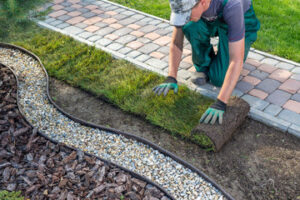Miami Outdoor Lighting makes your home and landscape feel welcoming after dark. It also highlights important features of your property and helps improve function and safety.
From relaxing on the porch to watching a soccer game, family activities get better with good light. Proper lighting wards off criminals and minimizes places for them to hide.

In-ground lighting is a great way to brighten your outdoor landscape and add some ambiance to your garden. These lights commonly highlight ponds, water gardens, fountains, and more. They can also illuminate pathways, patio flooring, and other hardscape surfaces. Ground lighting is available in various sizes and wattages depending on the type of light you need for your landscape.
Well, lights are a specific type of inground landscape lighting that can be installed into the ground or concrete. They typically have a circular or oval shape and are used for uplighting trees, architectural elements, or focal points. They can also illuminate walkways, paverstone patios, and other hardscape areas. Inground lights buried in the ground can also illuminate steps and stairs for safer navigation after dark.
When selecting inground landscape lighting, choosing a light color complementing your landscape is important. Warm white lights create a cozy and inviting atmosphere, while cool white light creates a more modern and sophisticated ambiance. You should also choose a light with a low glare to prevent any unwanted reflections in your outdoor space.
Inground Lighting should withstand harsh outdoor conditions and have good heat dissipation to avoid condensation and corrosion. They should be made from durable materials like pressed adze or 304# precision cast stainless steel. They should be properly sealed with a gasket to prevent water and debris from entering. This will keep the lights working properly and help them last longer.
Outdoor post lights can illuminate a driveway or garden pathway, but they’re also an easy way to boost your home’s curb appeal. Because these fixtures are often installed on poles exposed to the elements, choosing a “wet-rated” model is important, meaning it can withstand direct exposure to rain or moisture.
Whether you want to light your driveway so guests can safely park at night or you’d like to add a little extra charm to your front porch, these lighting options offer an abundance of design possibilities. You can also pair these fixtures with various other exterior lighting styles, such as wall sconces, to create a beautiful layered look that highlights the best features of your property.
Many of these models feature an adjustable lightbulb, so you can dim them for a cozy dinner or increase the brightness for a barbecue or pool party. This flexibility allows you to set the perfect mood for any occasion, making your outdoor space feel more like a relaxing extension of your home than an impersonal, darkened yard.
Most post lights are easy to install, but some may require a professional’s help due to their wiring. Solar post lights are typically a do-it-yourself project, while low-voltage fixtures may need to be wired by a licensed electrician. For those looking to save on energy costs, look for fixtures that use LED bulbs or are powered by a rechargeable battery. Many post lights also feature timers or sensors that let you control them automatically. This makes them a great option for homeowners who want to avoid turning their lights on and off daily.
Bollard lights are an outdoor lighting fixture that can help keep guests, customers, and employees safe when traveling in your business after dark. They can be used to create a physical barrier that prevents cars from entering areas where they are not supposed to, and they also come in many different shapes and styles that will match your landscape design.
These lighting fixtures are often made from concrete or other materials with good mechanical strength and impact resistance. They are ideal for public areas such as parking lots, driveways, plazas, and entranceways. They are typically designed to be mounted to the ground with a post or pillar, and they can be installed in multiple designs depending on your needs and the aesthetic of your property.
There are several options for bollard light colors and light output, including LEDs that offer a long lifespan, lower energy consumption, stable function in cold temperatures, and more. They can also be equipped with motion detectors and other features for extra security. If you want a traditional look for your bollards, consider a model that uses standard cone reflectors to diffuse the light in a 360-degree radius. Other bollard lights use specialized aluminum cones to reduce night pollution and glare, which can help make the area surrounding your bollards more comfortable.
To control them remotely, you can also incorporate bollards into your smart lighting system. You can schedule them to turn on every evening or set them to turn on a few minutes before you get home. Some bollards can be integrated into a Philips Hue system, allowing you to create automations that turn them on and off according to your schedule.
If you want to make a statement with your Lighting, look no further than wall sconces. These versatile fixtures can be used for ambient or task Lighting, and there are plenty of different designs to choose from. Ensure the sconces you select are rated for outdoor use and are mounted to a sturdy surface, such as a masonry wall or wooden post.
A sconce with an adjustable arm can let you point the light in any direction you need. This type of fixture is also ideal for spaces where you want a minimalist design. You can create a unique look by choosing sconces with a single material and finish, such as this brass transitional swing-arm sconce.
You can also choose sconces with a fixed arm to direct the light in one direction. These sconces are ideal for spaces needing a focused point of light, such as over a headboard or reading nook. Some sconces, such as this industrial droplet plug-in sconce, showcase a bare bulb. This type of sconce has an extra level of rustic charm and can be used in spaces requiring ambient and task lighting.
If you have a traditional aesthetic, look for conventional sconces that complement the architectural features of your home. These fixtures typically feature neutral metals and white or ivory glass, which can be found in various finishes. You can also find antique-inspired sconces, such as this Acclaim St. Charles sconce, designed to look like the colonial gas lanterns of yesteryear.
Many sconces come with a convenient pull chain that makes turning the fixture on and off easier than reaching up to turn a switch. If your sconces need a pull chain, adding one is easy. Just remove any lines of caulking or sealant around the existing mounting plate before installing a new sconce and follow the manufacturer’s directions for installation.
Turn any outdoor living space into a dreamy wonderland with hanging lights. The possibilities are endless, from lanterns and chandeliers to rope and twinkle-string lights. Choose just one or mix and match for a look unique to your home.
Use Lighting to define areas, guide guests, and highlight your favorite features and decor. Choose fixtures that are rated for the locations they’ll be used. This helps ensure that your fixtures can withstand the elements and provide a long lifespan.
Consider installing posts for support when using Lighting for a large area like a patio or pavilion. These posts can help bear the weight of your lights, preventing them from sagging or becoming unsafe. Drive your posts between two and three feet into the ground for best results. If you’re worried about putting holes in your exterior, opt for a post made from pre-cast concrete or cement block instead of a wood option.
You can easily install your hooks with a staple gun for smaller applications, such as a single strand of lights around a deck railing. Start near the power source and work out, stapling every few feet while keeping your general layout in mind. Leave enough slack for larger strands of lights to prevent tangling or crisscrossing.
If you need more time to get comfortable working with electricity, we recommend bringing in a professional to help with these more complex projects. Also, ensure you’re working with a licensed electrical contractor when installing any fixture requiring a licensed electrician.


